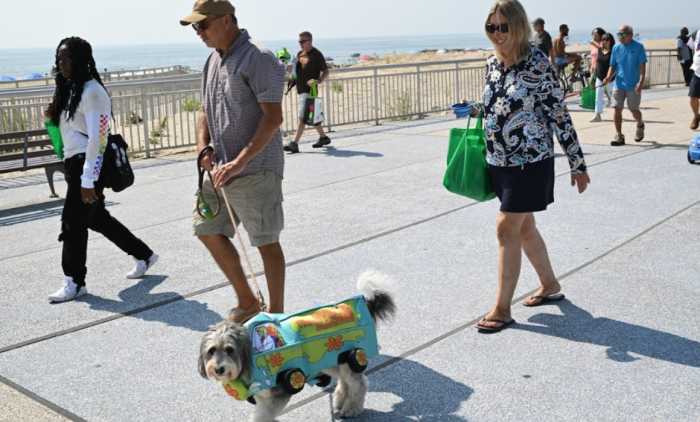By Debra Jenks
Giving new meaning to common materials, from the discarded to the domestic
DOZENS
David Ellis
Through June 28
Roebling Hall
606 W. 26th St.
(212-929-8180-8450; roeblinghall.com)
THE EXPONENT OF EARTH (YOU MAKE ME)
Jessica Jackson Hutchins
Derek Eller Gallery
Through June 21
615 W. 27th St.
(212-206-6411; derekeller.com)
PORTRAITS OF FAMILY AND FRIENDS
Andrew Sexton
Through June 21
Oliver Kamm/5BE Gallery
621 W. 27th St.
(212-255-0979; oliverkamm.com)
Ever since Marcel Duchamp turned a urinal upside down and deemed it art, the use of common materials has prevailed in sculpture. The canon of “non-conventional” mediums has informed generations, from the “Combines” of Rauschenberg to the varied mediums of Fluxus (a Latin word meaning “to flow”), to the consumer-culture kitsch of Jeff Koons.
David Ellis leaves no trashcan unturned. His musical kinetic sculptures (collaborations with composer Roberto Lange) are scavenged from refuse he finds on the street. Paint buckets, bottles and cans, shopping carts, broken bikes, cardboard boxes and the artist’s personal detritus are all given equal regard. The title of Ellis’ phenomenal show, “Dozens,” comes from a practice called “playing the dozens” or “doin’ the Dozens” (a.k.a. “Yo Momma Fights”), an African-American oral tradition where two competitors trade insults or “trash talk.”
Here, it’s literally the trash that does the talking. Ellis’s “Heap” is a rowdy hip-hop orchestra of percussive junk, a mountain of rubble animated by player piano actuators. Syncopated cans and bottles bang and clink. The work is playful, though it also calls attention to the enormous amount of waste we produce.
The most elaborate and layered piece in the show is “Oh Superman,” which pays homage to Laurie Anderson’s premonitory performance (and eponymous song). Ellis’s rhythmic “Oh Superman” is a combination typewriter and player piano. In the shape of Superman’s emblem, Anderson’s lyrics are typed on the piano rolls then mechanically cut and inserted into glass bottles, which roll off in random directions to deliver an S.O.S.: “Here come the planes. They’re American planes. Made in America.”
We see the same Superman emblem in a bird’s-eye view projection of Ellis’s painting the top of packing crates. Another reference to planes appears in a found text for airplane safety, used in one of a series of college panels hung throughout the gallery. The panels are composed of various texts and drawings, including his to-do lists, and a wave-like form resembling a graffiti tag.
Everything in this show moves or suggests movement. Flow is a key dynamic in Ellis’s art. The wave is a leitmotif that connects the various mediums used by the artist and carries us from one piece or room to the next.
Jessica Jackson Hutchins at Derek Eller Gallery takes her show’s title from an Emily Dickinson poem and a Richard Hell album cover. Her work weaves personal remnants with domestic objects—leftovers from her daughter’s birthday party, a video of the family vacation, vows spoken at her wedding, images cut from flower catalogs, furniture and misshapen ceramic vessels.
By drawing attention to deformity, Hutchinson challenges our notion of beauty that is flawless. In “Rocking Horse with Birthday Party Turf,” a child’s rocking horse is transmogrified into a cancerous monster à la Francis Bacon, its head and saddle covered with collaged lumps of plaster. A ceramic bottle resembling an ice pack sits on top of the shrouded head as if to relieve a headache or hangover. It’s humorous yet painfully sad — something has gone terribly awry.
“Convivium” is an odd feast. Ceramic dinner plates, pitchers and utensils sit on top of plaster forms that resemble an organic growth or geological outcropping in the Badlands. “Loveseat and Bowls” is a floral-patterned couch filled with plaster and topped with ceramic pots.
It looks as if it has suffered some catastrophic event, like an artifact dug from the ruins of Herculaneum. Forlorn objects, they have witnessed the calamities of time and bear the consequent sheen of purpose.
Andrew Sexton has a carney’s charm. He has a big moustache and a gold tooth. He comes from the populist vein of tattoos and comics (Joe Coleman came to his last opening). In addition to his ballpoint drawings of friends and family members as cartoon characters from naughty fairytales, there is Sexton’s folksy “Tribute to the Best Mom in the World” made of fake flowers and needlepoint. In the center of the gallery is “The Enigma of Kevin Sexton,” an ice-cream “portrait” of the artist’s brother as a wild boar, following in the iconoclastic practice of making sculpture of such unexpected material as wax, chocolate or even frozen blood.
At the opening of the show, Sexton’s brother was dressed like a Good Humor man in white with a bow tie, serving up his doppelganger to an enthusiastic crowd. They say you are what you eat. But one thing’s for certain, Andrew Sexton is no “bore.”




























